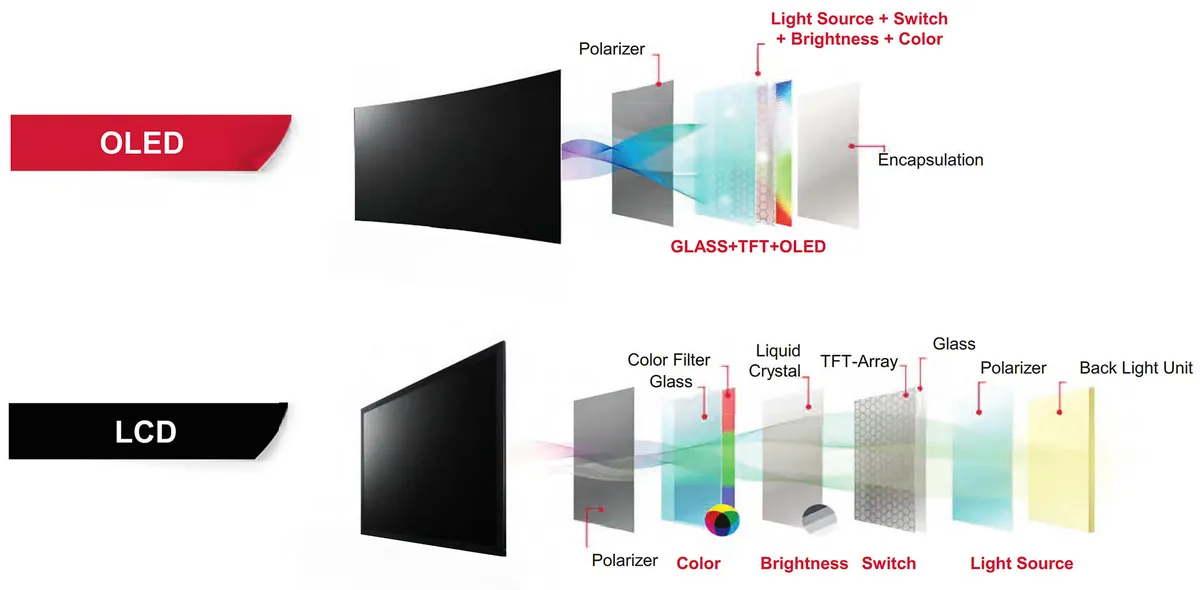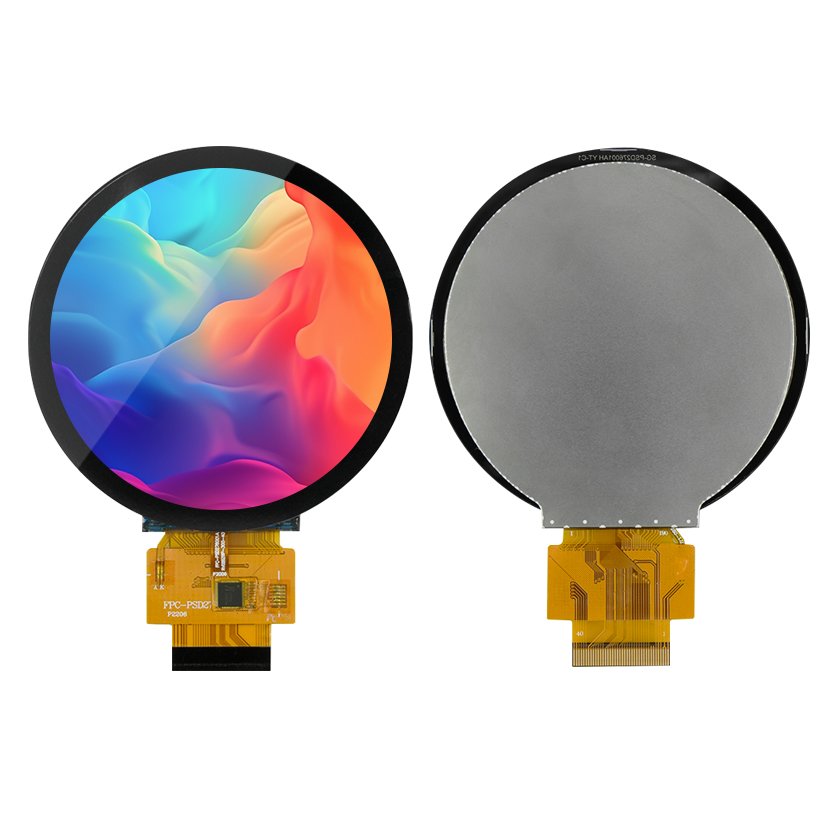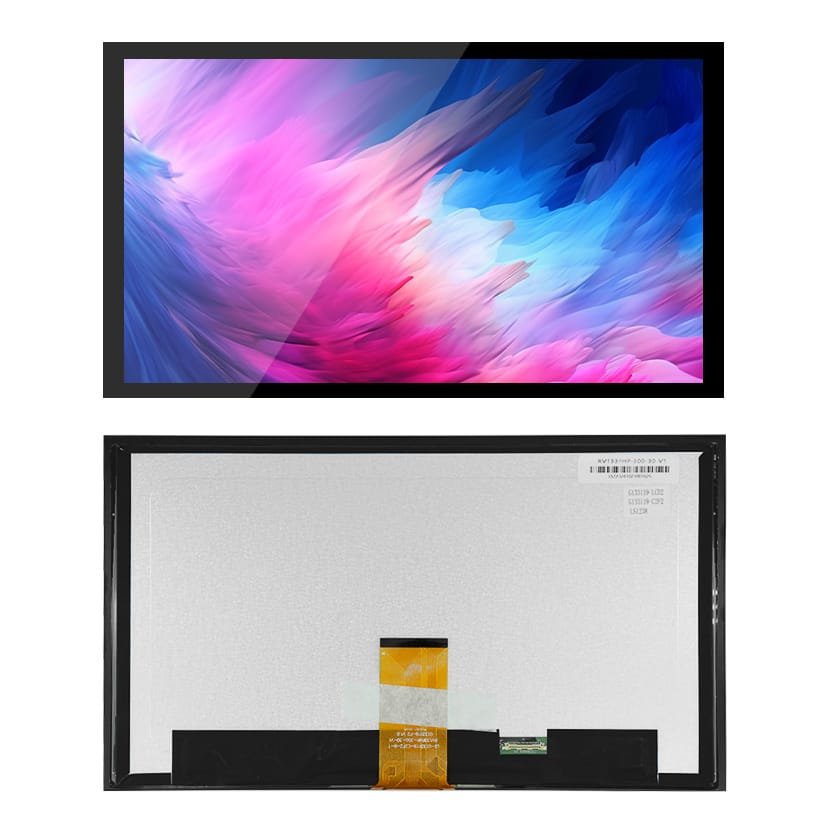In the previous article, we discussed the technical differences and application scenarios of LCD and OLED displays. To gain a deeper understanding of the advantages and limitations of these two display technologies, we will now delve into their complete structures.
I. The Complete Structure of LCD Displays
LCD (Liquid Crystal Display) technology has been a cornerstone of the display industry for decades. Its widespread use is attributed to its cost-effectiveness, versatility, and reliable performance. Below are the key components of an LCD display:
1. Liquid Crystal Layer
The liquid crystal layer is sandwiched between two glass or plastic substrates. It regulates the amount of light passing through it by aligning or misaligning in response to an electric current. The type of liquid crystal (e.g., TN, IPS, VA) determines the display’s viewing angles and color accuracy.
2. Backlight Unit
The backlight provides uniform illumination for the entire display. It typically uses LED (Light Emitting Diode) or CCFL (Cold Cathode Fluorescent Lamp) technology. High-end LCDs incorporate local dimming technology, which adjusts the brightness of specific areas to enhance contrast.
3. Color Filters
LCDs use red, green, and blue color filters to produce images. Each pixel consists of three subpixels corresponding to these colors. By controlling the alignment of the liquid crystals, the amount of light passing through each subpixel is adjusted to create the desired color.
4. Drive Circuit
The drive circuit converts video signals into electrical signals that control the orientation of the liquid crystals. This precise control allows the display to modulate light and generate images.
Through this structure, LCDs achieve precise control over light and color, making them cost-effective and reliable for a wide range of applications.
II. The Complete Structure of OLED Displays
OLED (Organic Light Emitting Diode) displays represent a significant advancement in display technology, offering superior image quality and unique features. Their structure differs fundamentally from LCDs:
1. Organic Material Layer
This is the core of OLED technology. Organic compounds emit light when an electric current is applied, creating self-emissive pixels. Each pixel comprises red, green, and blue subpixels, which can be individually controlled for precise light and color management.
2. Electrode Layers
The OLED structure includes anode and cathode layers. The anode is typically made of transparent conductive material to allow light to pass through, while the cathode applies the voltage needed to activate the organic layer.
3. Substrate
The substrate serves as the foundation for the OLED structure, usually made of glass or flexible plastic. Flexible substrates enable OLED displays to bend or fold, paving the way for innovative device designs.
4. Encapsulation Layer
To protect the organic materials from moisture and oxygen, encapsulation layers are added. These high-seal materials extend the lifespan of the display by preventing degradation of the organic compounds.
The self-emissive nature of OLEDs allows them to achieve true blacks, infinite contrast ratios, and wider viewing angles, making them superior to LCDs in terms of image quality.
III. Impact of Display Structure on Performance
The structure of LCD and OLED displays plays a crucial role in determining their performance. Below are the key factors influenced by their designs:
1. Response Time
- LCD: Relies on the alignment speed of liquid crystals, typically measured in milliseconds. This can result in motion blur during fast-moving scenes.
- OLED: Each pixel can turn on and off in microseconds, significantly improving motion handling and making it ideal for gaming and action-packed videos.
2. Viewing Angles
- LCD: Viewing angles are limited by the backlight and liquid crystal alignment. TN panels have narrow viewing angles, while IPS and VA panels perform better.
- OLED: Maintains consistent color accuracy and brightness even at extreme viewing angles, offering a superior viewing experience.
3. Contrast Ratio
- LCD: Limited by the backlight, achieving true blacks is challenging even with local dimming technology.
- OLED: Can completely turn off individual pixels, enabling true blacks and an infinite contrast ratio.
4. Power Consumption
- LCD: Consumes consistent power due to the constant backlight, even when displaying black content.
- OLED: More energy-efficient when displaying dark content, as it can turn off pixels. However, bright or white content may consume more power.
IV. Manufacturing Process Differences
1. LCD Manufacturing
LCD manufacturing is a mature and stable process. The injection of liquid crystals and the production of backlights are well-established, making LCDs cost-effective and reliable. However, advancements in LCD technology have plateaued, limiting further improvements in display quality.
2. OLED Manufacturing
OLED manufacturing is more complex, involving the precise deposition of organic materials and encapsulation processes. This increases production costs but results in displays with superior performance. However, the organic materials used in OLEDs are prone to degradation over time, leading to issues like burn-in and reduced brightness.
V. Future Trends in Display Technology
1. MicroLED Technology
MicroLED combines the best of LCD and OLED technologies. It uses an array of microscopic LEDs for self-emissive pixels, offering high brightness, energy efficiency, and long lifespan. Although still in development, MicroLED is poised to become a dominant display technology in the future.
2. Flexible Displays
The use of flexible substrates in OLED displays enables innovative device designs, such as foldable smartphones and rollable TVs. As manufacturing techniques improve, flexible displays are expected to become more mainstream.
3. Quantum Dot Technology
Quantum dots are nanocrystals that enhance color accuracy and brightness when applied to LCD or OLED displays. This technology is already being used in QLED (Quantum Dot LED) displays and is expected to play a significant role in the future of display technology.
Conclusion
By examining the complete structures of LCD and OLED displays, we can better understand their strengths and limitations. LCDs remain a reliable and cost-effective option, while OLEDs offer unparalleled image quality and innovative designs. As technology evolves, emerging technologies like MicroLED and quantum dots promise to push the boundaries of display performance even further.
Understanding these structural differences empowers consumers and professionals to make informed decisions when choosing display technologies for their specific needs. Whether it’s for everyday use or cutting-edge applications, the right display can significantly enhance your experience.
















